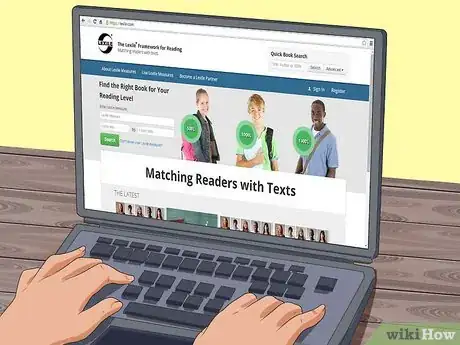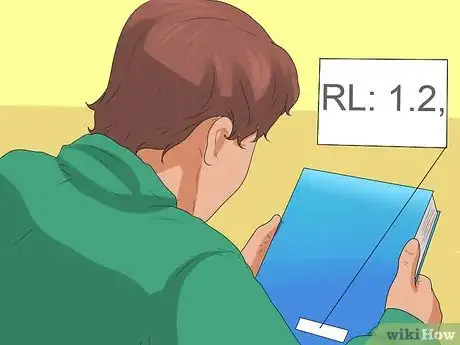X
wikiHow is a “wiki,” similar to Wikipedia, which means that many of our articles are co-written by multiple authors. To create this article, volunteer authors worked to edit and improve it over time.
There are 7 references cited in this article, which can be found at the bottom of the page.
This article has been viewed 39,636 times.
Learn more...
Reading is a very important skill in a child’s development and plays a huge role in their learning opportunities and life experiences. Help your kids establish a love for learning by encouraging them to read books at the proper reading level.
Steps
Part 1
Part 1 of 3:
Understanding the Testing Methods
-
1Find out which reading level system is used in your area. There are a variety of reading level systems; some are more popular in certain regions than others.[1]
- To test your child’s reading level, it is helpful to know which system is used in your area—ask the local school district or school to find out and to provide you with more information.
- Reading levels can be converted from one program to another, so check with your local librarian or your child’s teacher to see how their skills correlate to another program.
-
2Find out more about the Accelerated Reader system. AR is a popular program in public schools and comes in a desktop or web-based version.[2]
- Children take a test through the program, which then recommends books at or slightly above their reading levels. AR levels are arranged by numbers, such as 2.0, 2.1, etc.
- The first number correlates with your child’s grade level and the second number with what month in the school year is standard for that book. For example, a book labeled level 2.3 would be at the level of a typical second grader in their third month of school.
Advertisement -
3See if your child's school follows the Guided Reading Levels. GRL is arranged on an alphabetical scale, with level A being the easiest and level Z the most advanced.[3]
- GRL tests are typically administered at the beginning of each school year by having the child read individually to his teacher from a book considered standard for the grade.
- The teacher may ask follow-up questions to test for vocabulary and comprehension, and then uses her judgment and the GRL Reading Record to calculate a reading level.
-
4Determine if your child’s school follows the Developmental Reading Assessment. DRA is tested in a similar way to GRL, with a child reading a book aloud to their teacher at the beginning of the school year.
- The child will then retell the story to their teacher and be scored on a variety of skills, ranging from accuracy to fluency.
- DRA books start with level A, and then switch to numbers 1-80 for more difficult books.
-
5Look into Lexile. Lexile measures are given from a Scholastic Reading Inventory assessment given by the school, or taken from standardized tests.
- Using a child’s standardized test reading scores, an educator or parent can covert the scores into a Lexile measure.
- Lexile uses more quantitative measures, such as sentence length and number of syllables in a word, instead of qualitative measures, such as analysis or comprehension. The scale runs from 0L to 2000L.
Advertisement
Part 2
Part 2 of 3:
Testing Your Child’s Reading Level at Home
-
1Examine your child’s favorite books. A simple way to find your child’s reading level is to look at the back of their favorite books. Towards the bottom of the back cover, near the price and barcode, there should be a number such as RL:1.2, which means that book is an average book for a first grader.[4]
- Take a handful of your child’s current favorites and average the reading levels to give you a fairly good idea of his actual reading level.
- This system isn’t foolproof, as children sometimes choose books on their own that are below their reading level, but it will give you a good starting point.
-
2Have your child participate in an online test. There are a variety of online tests that can be done with your child at home to further understand their reading level.[5]
- Many free tests involve lists of words—have your child read each word in the list out loud. When they get to a point where they can’t read 4 or 5 words in a row or they get too frustrated to continue, stop and use that stopping spot to measure the reading level.
- These lists can be found on websites like sonlight.com and mindsprinting.com. Note that these online word tests are fairly accurate for determining reading level, but don’t test comprehension or contextual reading.
-
3Look into the DORA exam. For a more comprehensive online test, consider paying for the DORA exam, which costs around $20.
- The exam, and other similar diagnostic reading tests, evaluate a child’s ability in multiple reading skill sets from word recognition to spelling and oral vocabulary.
- DORA is available through letsgolearn.com.
-
4Encourage your child to read books at home. Once you know your child’s reading level, you can continue their progress by encouraging them to read books at their correct level at home, either to themselves or aloud to parents or siblings.[6]
Advertisement
Part 3
Part 3 of 3:
Testing Your Child’s Reading Level at School
-
1Know that your child will be tested each year. If your child is in school outside of the home, they will most likely be subjected to school reading tests each year. These results should be accessible by parents and open for discussion with your child’s teacher.
-
2Understand that testing is based on the school’s regulations. How a school tests a child's reading level depends on state regulations and the procedures of the school district.
- Some states use annual standardized tests as a way to determine reading levels. These tests are often multiple choice and cover a variety of reading subjects to produce a well-rounded reading level.
- Other schools test the children individually at the beginning of every school year. These tests can be offered in person or on the computer and generally draw their questions from the school’s corresponding reading level program.
-
3Stay updated on your child’s reading progress by having an open relationship with their teacher. Ask about your child’s reading level during parent-teacher conferences throughout the year and ask for recommendations for books or reading activities you could implement at home.[7]
- You could also have a periodic call or email with your child’s teacher after reading assignments or reading groups to see how they are progressing.
- Establishing an open relationship with the teacher will also help them come to you as soon as they spot a reading red flag.
Advertisement
References
- ↑ https://www.perma-bound.com/static/common-core/EC_Correlation_Lexile_Poster_12_NEW.pdf
- ↑ https://www.scholastic.com/teachers/articles/teaching-content/leveled-reading-systems-explained/
- ↑ https://www.scholastic.com/teachers/articles/teaching-content/leveled-reading-systems-explained/
- ↑ https://www.understood.org/en/school-learning/learning-at-home/encouraging-reading-writing/4-steps-to-choosing-books-at-your-childs-reading-level
- ↑ https://www.understood.org/en/school-learning/learning-at-home/encouraging-reading-writing/4-steps-to-choosing-books-at-your-childs-reading-level
- ↑ https://www.readbrightly.com/just-right-book-reading-levels-explained/
- ↑ https://teach.com/blog/3-strategies-to-involve-parents-in-children-education/
- http://dearteacher.com/content/find-your-childs-reading-level
- http://www.scholastic.com/parents/resources/article/book-selection-tips/assess-dra-reading-levels
About This Article
Advertisement






























































